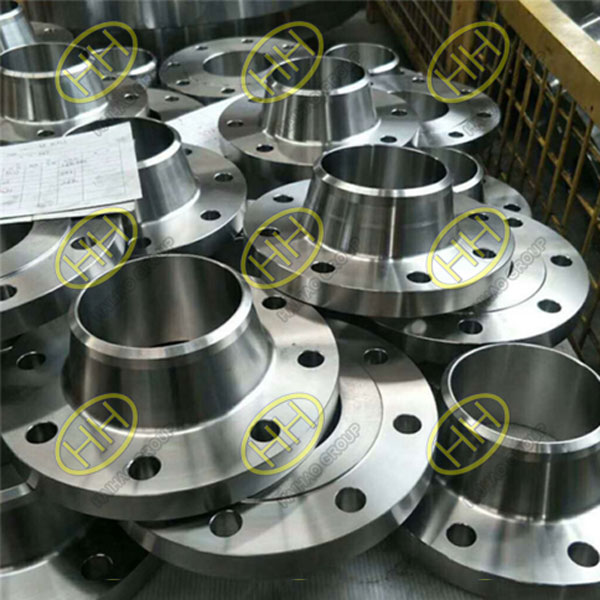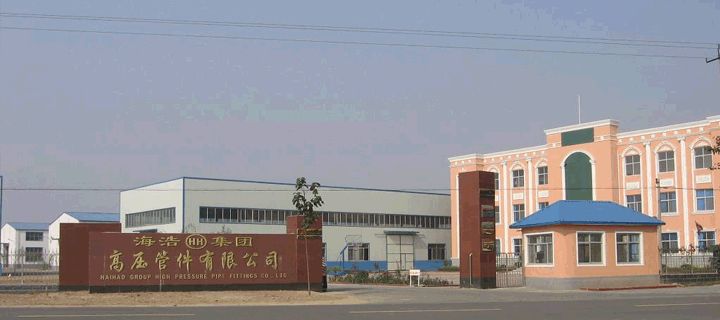The ASME B16.5 standard governs the specifications for pipe flanges and flanged fittings used in various piping applications. This standard is widely recognized in industries such as oil and gas, petrochemicals, power generation, and water treatment, ensuring safe and reliable connections in piping systems.
ASME B16.5 Standard Pipe Flanges Dimensions:
ASME B16.5 Weld Neck Flange Dimensions (150lb-2500lb)
ASME B16.5 Slip On Flange Dimensions (150lb-1500lb)
ASME B16.5 Blind Flange Dimensions (150lb-2500lb)
ASME B16.5 Socket Weld Flange Dimensions (150lb-1500lb)
ASME B16.5 Lap Joint Flange Dimensions (150lb-2500lb)
ASME B16.5 Threaded Flange Dimensions (150lb-2500lb)
Haihao Group forged flanges engineering department,design,produce,inspect and supply our forged flanges according to the ASME B16.5 standard.The following is a detailed description of ASME B16.5 standard:
-
- 1. SCOPE
- 2. PRESSURE-TEMPERATURE RATINGS
- 3. COMPONENT SIZE
- 4. MARKING
- 5. MATERIALS
- 6. DIMENSIONS
- 7. TOLERANCES
- 8. PRESSURE TESTING

ASME B16.5 RF ASTM A694 GR.F65 weld neck flanges
5 MATERIALS
5.1 General
(a)Materials required for flanges and flanged fittings are listed in Table 1.1-1 with the restrictions:
(1)Plate and flat bar materials may be used only for blind flanges and reducing flanges without hubs.
(2)Flanges and flanged fittings shall be manufactured as one piece in accordance with the applicable material specification.Assembly of multiple pieces into the finished product by welding or other means is not permitted by this Standard.
(b)Each forged flange shall be finished from a part that is brought as nearly as practicable to the finished shape and size by a compressive plastic hot-working operation that consolidates the material to produce an essentially wrought structure,and shall be so processed during the operation as to cause metal flow in the direction most favorable for resisting the stress encountered in service.
(c)Recommended bolting materials are listed in Table 1.1-2 (see para.5.3).
(d)Corresponding materials listed in Section II of the ASME Boiler and Pressure Vessel Code may be used provided that the requirements of the ASME specification are identical to or more stringent than the ASTM specification for the Grade,Class,or type of material.
5.1.1 Application. Criteria for the selection of materials are not within the scope of this Standard. The possibility of material deterioration in service should be considered by the user. Carbide phase conversion to graphite and excessive oxidation of ferritic materials, susceptibility to intergranular corrosion of austenitic materials, or grain boundary attack of nickel base alloys are among those items requiring attention. A discussion of precautionary considerations can be found in ASME B31.3, Appendix F; Section II, Part D, Appendix 6; and Section III, Division 1, Appendix W of the ASME Boiler and Pressure Vessel Code.
| Material Group No. | Nominal Designation | Pressure Temperature Rating Table | Applicable ASTM Specifications | ||
| Forgings | Castings | Plates | |||
| Group 1 Materials | |||||
| 1.1 | C-Si C-Mn-Si C-Mn-Si C-Mn-Si-V 3½Ni |
2-1.1 2-1.1 2-1.1 2-1.1 2-1.1 |
A105 A350 Gr.LF2 … A350 Gr.LF6 CI.1 A350 Gr.LF3 |
A216 Gr.WCB … … … … |
A515 Gr.70 A516 Gr.70 A53 7Cl.1 … … |
| 1.2 | C-Mn-Si C-Mn-Si C-Mn-Si-V 2½Ni 3½Ni |
2-1.2 2-1.2 2-1.2 2-1.2 2-1.2 |
… … A350 Gr.LF6 Cl. 2 … … |
A216 Gr.WCC A352 Gr.LCC … A352 Gr.LC2 A352 Gr.LC3 |
… … … A203 Gr.B A203 Gr.E |
| 1.3 | C-Si C-Mn-Si 2½Ni 3½Ni C-½Mo C-½Mo |
2-1.3 2-1.3 2-1.3 2-1.3 2-1.3 2-1.3 |
… … … … … … |
A352 Gr.LCB … …A217 Cr. WC1 A352 Gr.LC1 |
A515 Gr. 65 A516 Gr. 65 A203 Gr.A A203 Gr.D … … |
| 1.4 | C-Si C-Mn-Si |
2-1.4 2-1.4 |
… A350 Gr. LF1 Cl.1 |
… … |
A515 Gr. 60 A516 Gr. 60 |
| 1.5 | C-½Mo C-½Mo |
2-1.5 2-1.5 |
A182 Gr.F1 … |
… … |
A204 Gr. A A204 Gr. B |
| 1.7 | ½Cr-½Mo Ni-½Cr-½Mo ¾Ni-¾Cr-1Mo |
2-1.7 2-1.7 2-1.7 |
A182 Gr.F2 … … |
… A217 Gr. WC4 A217 Gr. WC5 |
… … … |
| 1.9 | 1¼Cr-½Mo 1¼Cr-½Mo-Si |
2-1.9 2-1.9 |
… A182 Gr. F11 CL.2 |
A217 Gr. WC6 … |
… A387 Gr. 11 Cl.2 |
| 1.10 | 2¼Cr-1Mo | 2-1.10 | A182 Gr. F22 CL.3 | A217 Gr. WC9 | A387 Gr. 22 Cl.2 |
| 1.11 | C-½Mo | 2-1.11 | … | … | A204 Cr.C |
| 1.13 | 5Cr-½Mo | 2-1.13 | A182 Gr. F5a | A217 Gr. C5 | … |
| 1.14 | 9Cr-1Mo | 2-1.14 | A182 Gr. F9 | A217 Gr. C12 | … |
| 1.15 | 9Cr-1Mo-V | 2-1.15 | A182 Gr. F91 Type 1 | A217 Gr. C12A | A387 Gr. 91 Cl.2 |
| 1.17 | 1Cr-½Mo 5Cr-½Mo |
2-1.17 2-1.17 |
A182 Gr. F 12 Cl.2 A182 Gr. F5 |
… … |
… … |
| 1.18 | 9Cr-2W-V | 2-1.18 | A182 Gr. F92 | … | … |
5.1.2 Toughness. Some of the materials listed in Table1.1-1 undergo a decrease in toughness when used at low temperatures, to the extent that Codes referencing the Standard may require impact tests for application even at temperatures higher than −7°C (+20°F). It is the responsibility of the user to assure that such testing is performed.
5.1.3 Responsibility. When service conditions dictate the implementation of special material requirements [e.g., using a Group 2 material above 538°C (1000°F)], it is the user’s responsibility to so specify to the manufacturer in order to ensure compliance with metallurgical requirements listed in the notes in Tables 2-1.1 through 2-3.19(Tables 2-1.1C through 2-3.19C)
5.1.4 Cast Surfaces. Cast surfaces of component pressure boundaries shall be in accordance with MSS SP-55 except that all Type I defects are unacceptable and defects in excess of Plates “a” and “b” for Type II through Type XII are unacceptable.
5.2 Mechanical Properties
Mechanical properties shall be obtained from test specimens that represent the final heat treated condition of the material required by the material specification.
5.3 Bolting
5.3.1 General. Bolting listed in Table 1.1-2 is recommended for use in flanged joints covered by this Standard. Bolting of other material may be used if permitted by the applicable code or government regulation. Bolting materials are subject to the limitations given in paras.5.3.2 through 5.3.5.
5.3.2 High Strength Bolting. Bolting materials having allowable stresses not less than those for ASTM A 193 Grade B7 are listed as high strength in Table 1.1-2. These and other materials of comparable strength may be used in any flanged joint.
5.3.3 Intermediate Strength Bolting. Bolting materials listed as intermediate strength in Table 1.1-2, and other bolting of comparable strength, may be used in any flanged joint provided the user verifies their ability to seat the selected gasket and maintain a sealed joint under expected operating condition.
5.3.4 Low-Strength Bolting. Bolting materials having no more than 206 MPa (30 ksi)specified minimum yield strength are listed as low strength in Table 1.1-2.These
materials and others of comparable strength are to be used only in Class 150 and 300 flanged joints (see para.5.4.2 and Nonmandatory Appendix B).Flanged assemblies using low-strength carbon steel bolts should not be used above 200C (400F)or below -29℃(-20°F).
At Haihao Group, we specialize in providing a full range of ASME B16.5 pipe flanges and flanged fittings. Whether you’re looking for weld neck flanges, slip-on flanges, blind flanges, or any other type, we have the expertise and products to meet your specific needs.
If you want to learn more about our product offerings or have any inquiries, please feel free to contact us. We look forward to partnering with you for all your piping needs.







